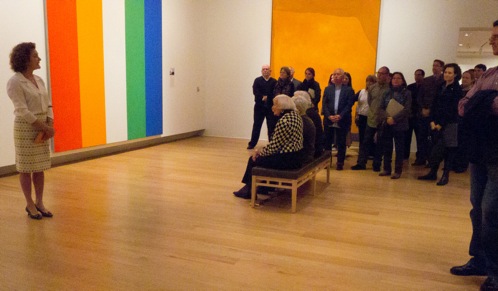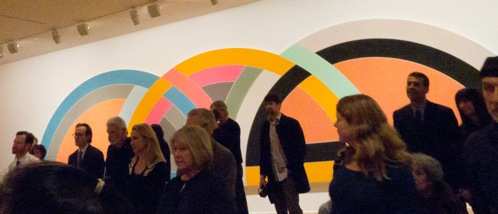The Norton Simon Museum has the best collection of art in Southern California. This is the last museum that should ever have to acquire modern and contemporary work to play catch-up to the art world. This is an institution that can hold back and wait for the world of art to create works great enough for its walls. "Surface Truths: Abstract Painting in the Sixties" is the title of an exhibition that has just opened there. It features sixteen oversized formalist paintings that are nothing if not classical examples of second-generation abstract painting.
Because of the complicated manner in which the Norton Simon museum as it presently exists came to be, its holdings include some big abstract paintings from the 1960s despite Mr. Simon's distaste for nonobjective art. Sixteen of them comprise "Surface Truths". A few of the works in the show are by artists who are household names in households that discuss big abstract paintings (Agnes Martin, Helen Frankenthaler, Frank Stella, Robert Irwin). Some works are by obscure abstract painters. One painting is by an artist (Joseph Vaughn) who the museum admits (on the wall placard) to having no idea of his whereabouts or work after the late 1960s. Some of these works have been on long-term loan to other local museums and have now returned home.

Curator Gloria Williams discusses "SURFACE TRUTHS" flanked by Ellsworth Kelly and Helen Frankenthaler paintings.
For all its glory, the Norton Simon is a tiny physical space and any additional square footage added to its floor space over the years has been lacking one critical component necessary to exhibiting a large swath of modern and contemporary art: high ceilings. And then of course there is the built-in bias: the Norton Simon brand is so associated with representational work that having masterpieces of abstract painting in its collection is like having a porn star with a high IQ: the visitors are here for something else and they will hardly notice let alone ever appreciate it.
And so there we were, enjoying the remarks of Norton Simon curators Carol Togneri and Gloria Williams in a most un-Norton Simon exhibit. Or was it? Unlike any of the art that the museum is noted for, "Surface Truths" was the art of Norton Simon's own time. At the height of Mr. Simon's material lust he derided the abstract painting blossoming in the headlines around him. A master of all he surveyed, he sought to own history in the form of the trophies of yesterday. Like bold mid-century abstraction, Norton Simon had that epic American ego. As the paintings became bigger and bigger, did they not reflect some capitalist greed for real estate? Was Mr. Simon's "collecting bug" not a manifestation of a belief in nothing beyond one's own material presence?

The sixties gave us oversized Frank Stella paintings and the song with the line "A crowd of people turned away"...
It must, though, be asked: does this abstract painting reflect its times? Can we connect with the collective consciousness of the 1960s through this art? Neither curator in their brief remarks would venture much speculation about content, meaning or historical interconnectivity. Sixties abstraction was championed in its time as formalism; remarkably, it retains that contextual purity and is still only officially discussed in this capacity. While a brief mention of the tumult of the decade of the 1960s was included by Ms Togneri in her introduction of the show's lead curator Ms Williams, the conversation was devoted to the work's formal properties. Nobody can blame them for this - the last four decades of scholarship in the field stays in lockstep: Content is form and nothing but the form.
"Surface Truths" is, thusly and ultimately, a somber, sad exhibition. The sixties just recede further in the rearview mirror while these perfectly preserved relics are forbidden to speak to us at all. This grand art made at the peak of an empire is still confined to its materials, color and geometry. There were great Catholic painters just after the Renaissance who insisted that their work was entirely about the religious content and was not to be appreciated by non-believers for technique, influence and formal properties. They did not get their way.
But Frank Stella's maxim of "What you see is what you see" is religiously regarded a half century later. In the mid-sixties, that Buddhist Monk was photographed immolating himself. Are these paintings possibly pictorial immolations of content? Could these artists have possibly been seeking to become the same type of phoenix as that silent flaming monk? Did these painters destroy form to create some greater meaning? That Monk annihilated form in the insane quest for results. Does the abstract painting of that same era seek a different world than one in which the dismissal of an abstract painting is the only way to celebrate it? Maybe someone somewhere sometime will give a narrative construct to this generation of painters as more than afterthoughts to the most fractured decade of the twentieth century. These artists managed to dissolve meaning so thoroughly that a gas-can could hardly have done better. There has got to be some deeper truth beneath the surface.
SURFACE TRUTHS Abstract Painting in the Sixties is on view through August 15, 2011.
